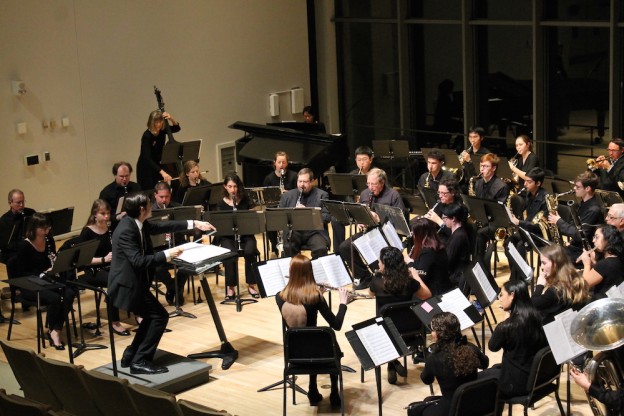At 8:00 P.M. on Nov. 18 in Lang Concert Hall, the Swarthmore College Wind Ensemble, conducted by Professor Andrew Hauze, will bring its audience back to the early 20th century–back to the time of piano four-hands played in British and American homes, of ragtime in bars and brothels and dance halls, and of charismatic folk singers.
The hour-long concert will open with Lincolnshire Posy, an experimental fantasia by Australian composer Percy Grainger. Each of the six movements of the Lincolnshire Posy represents a different folk song that Grainger heard in his tour around the small villages of Lincolnshire. The folk songs memorialize historical events, including an unresolved feud between friends and the story of a missing sailor, once thought dead, returning home to his betrothed.
“In the music, it’s really interesting for the performer to see, ‘Okay, how’s Grainger taking this story and reimagining it in the way that he writes for the instruments?’” Hauze said. “Percy Grainger is not a household name, particularly in America, but he wrote some of the most original music you’ll hear. It has very traditional material so it’s very approachable—there’s a tune, you’ll get that—but at the same time it goes in these directions…when you listen to it and then you step back from it, it takes a moment to fully realize what you’ve heard.”
The second half of the concert will begin with dances composed by Antonín Dvořák. Dvořák’s mentor, Johannes Brahms, had written wildly successful Hungarian dances and suggested that Dvořák do the same. “These composers are mostly writing symphonies and very serious chamber music and in some cases opera, and these are kind of prestige things, but they’re not necessarily big moneymakers,” Hauze said. Some of Dvořák’s most popular and lucrative pieces were the Slavonic dances he then wrote, inspired by his home, the Czech lands. They were piano four-hands duets performed for family and friends as a favorite pastime of middle-class Europeans and Americans in the early 20th century.
In addition, the wind ensemble will perform “Danzon,” a Cuban-inspired piece from Leonard Bernstein’s score for a ballet called Fancy Free. “[“Danzon”] is also a little homage to Bernstein, because he’s entering his centennial year,” Hauze said. “He’s also one of my favorite composers, and wind ensemble in particular plays a lot of Bernstein. It’s really well suited to the group.”
The closing piece of the concert is “The Thriller,” a ragtime piano piece composed by May Aufderheide that Hauze arranged for wind and percussion instruments. According to Hauze, Aufderheide and her contemporary Julia Lee Niebergall were especially notable as a female composers from Indianapolis. “They weren’t in New York, they weren’t in one of the major metropolises, and they were women, and ragtime was dominated by male composers, both black and white,” Hauze said. “They wrote some great rags but they’re mostly kind of forgotten these days, and I really like to play them on the piano, so I thought it would be fun to start making some arrangements for wind ensemble.”
The link between the varied compositions chosen for the concert is that none were written as concert pieces; they were intended to be sung or danced along to. The lively and lighthearted rhythm of the concert may just make it hard to stay sitting down.
Bayliss Wagner ’21
